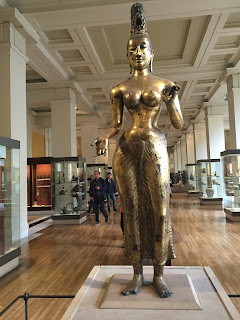
Soon we had left London behind and were passing through pastoral countryside.
Before long we reached Wales...a land of rugged seacoast, tidy farmland, and ancient castles.
Across a causeway, we reached Holy Island, and Holyhead Port. Inside the city is one of Europe's few remaining three-wall Roman forts, the fourth being the sea. It is believed that people have been traveling between here and Ireland for four-thousand years.
After boarding our Irish Ferries vessel, we sat back and enjoyed our blue sky passage across the Irish Sea.
In less than two hours, we reached Dublin port.
En route to the hotel, our taxi driver showed us the sights, including the Central Post Office, its bullet holes marking The Rising against British rule.
This is the centennial of the bloody 1916 event--and no one seems to have forgotten.
Our hotel was on Stephen Street across from the Hairy Lemon Pub, a local landmark, our driver told us. Remember the name and we would never be lost. I looked forward to having my own neighborhood pub!
The next morning, we met a friend for breakfast and wandered to Dublin Castle, seat of the UK administration until the Anglo-Irish Treaty of 1921.
We wandered the Old Town streets, cobbled and quirky.
Our morning's highlight was the outstanding Chester Beattie Library, with its superlative collections, "Sacred Traditions" and "Artistic Traditions," featuring manuscripts, prints, books, and artifacts of the Islamic, Far Eastern, and European worlds. Photos are not allowed, so you must visit yourselves!
Afterward, we happened upon a popup exhibit by Alison Hackett, author of The Visual Time Traveller, a unique history of the world that should be in every school. Alison commissioned artists to create pages grouping major landmarks of time. The following image notes such events as the forcible relocation of the Cherokee people in 1835 and the first photo of the moon in 1839.

In the style of the late '60s Fillmore concert posters, this image commemorates the 1968 film, 2001: A Space Odyssey, Neil Armstrong's 1969 walk on the moon, and, in 1966, Indira Gandhi becoming prime minister of India, one of the first women elected to lead a nation.
We ended the afternoon at Trinity College and the Long Room Library.
Here we visited the exhibit of the Book of Kells, an ancient manuscript of the Four Gospels, with lavish illustrations by three monk-artists. Four monk-scribes transcribed the text. The following poems make two of them come alive.
That evening, we crossed the River Liffey to North Dublin and gawked at the soaring spire.
A block away, we paused to chat with James Joyce.
The next morning I walked to St. Patrick's Cathedral.
I lunched at a popular local spot, Fumbaly, which quotes Don Quixote, "All Sorrows are less with bread." I agree heartily.
Here we visited the exhibit of the Book of Kells, an ancient manuscript of the Four Gospels, with lavish illustrations by three monk-artists. Four monk-scribes transcribed the text. The following poems make two of them come alive.
That evening, we crossed the River Liffey to North Dublin and gawked at the soaring spire.
A block away, we paused to chat with James Joyce.
The next morning I walked to St. Patrick's Cathedral.
I lunched at a popular local spot, Fumbaly, which quotes Don Quixote, "All Sorrows are less with bread." I agree heartily.
Continuing through south Dublin, I encountered a cottage with this plaque: Here in Joyce's Imagination was born in May 1966, Leopold Bloom, Citizen, Husband, Father, Wandered, Reincarnation of Ulysses.
I soon reached the Grand Canal, following it for several blocks.
I circled back up to St. Stephens park, which was packed on this lovely Sunday afternoon. Here I again met up with James Joyce, the patron saint of Literary Dublin.
That evening we bid farewell to Dublin at our favorite neighborhood pub, the Hairy Lemon.
Last stop: Edinburgh http://dianarchambers.blogspot.com/2016/09/europe-by-train-last-stop-edinburgh_76.html
























































